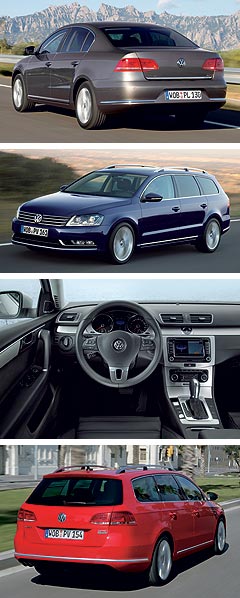Future models - Volkswagen - PassatPassat goes for technologyPutting the boot in: The new Passat will debut ‘Easy Open’ boot/tailgate release technology activated by kicking the space beneath the rear bumper. VW’s next-gen mid-sizer gains refinement and Audi-type tech but loses R36 flagship8 Nov 2010 VOLKSWAGEN will launch the next-generation Passat in Australia in the second quarter of next year with a raft of new refinements and advancements, including idle-stop fuel-saving technology on the 125TDI. Like now, there will be diesel and petrol engine choices, including a V6 all-wheel drive flagship, with pricing that should be pegged at about current levels ($38,990 to $57,990). But the Passat BlueMotion model that has made headlines in Europe will not be part of the line-up initially and, at the other end of the spectrum, the popular R36 will vanish, falling victim to downsizing trends as manufacturers globally strive to lower fuel consumption and emissions.  A Golf R-style turbocharged 2.0-litre AWD replacement may eventually arrive, although Volkswagen has yet to confirm its existence. A Golf R-style turbocharged 2.0-litre AWD replacement may eventually arrive, although Volkswagen has yet to confirm its existence.Known as the B7 series, the new Passat was unveiled at the Paris Motor Show in late-September and is a clever reskin and refinement exercise of the outgoing B6 launched in 2005. In fact, much of the drivetrain and platform components – shared with the smaller Golf – are re-employed, making this car essentially a Passat B6.5. This means it has a transverse-mounted engine, MacPherson strut front suspension, four-link rear suspension and electro-hydraulic powered rack-and-pinion steering. Nevertheless, the sheetmetal is essentially all-new – only the roof and doors carry over in the sedan – while the interior has been completely revamped for a greater luxury feel and ambience. There will be a big increase in luxury gadgets on offer, such as a fatigue detection system that gauges reaction times to alert a drowsy driver and a Volvo XC60-style emergency braking function that uses radar to significantly retard motion at up to 30km/h to either avoid an object or mitigate the effects of an impact. Coming to Australia late in 2011 will be a world-first ‘Easy Open’ boot/tailgate release that allows a Passat driver with arms full to open it by kicking the space beneath the rear bumper. Improvements to existing extra-cost technologies include Park Assist II, which can park a Passat in a smaller gap than before (down from 140cm to 80cm either end), and even allows for a clean exit if the gap between the parked cars in the meantime reduces by up to another 25cm at either end. There is also an anti-dazzle headlight function called ‘Dynamic Light Assist’ that alters the beam for oncoming traffic, a blind-spot warning feature known as ‘Side Assist’ and a front camera to detect (and display) speed limit signs. Optional on some models (although not all will be made available to Australian buyers), these form part of an improved safety story that now runs to rear seatbelt fastening detection, and horizontal adjustment for the front head restraints – which now also benefit from anti-whiplash design. As before, a five-star ENCAP safety rating is expected. To help banish fatigue, Volkswagen has reduced noise intrusion with the installation of insulating film in the windscreen (as per the latest Golf) and sound-deadening material ahead of the dashboard and doors, while “high-end” tactile and visual materials are employed on the dash, seats, door cards, console and ceiling, supported by better use of ambient lighting. Noise-reducing side windows are also on the extras list, as is DCC adaptive chassis control that alters the dampers between Comfort, Normal and Sport settings. For Australia, the trio of powertrain choices (out of ten available internationally) will be familiar, although all boast significant economy gains. Apart from the AWD V6, of course, drive is to the front wheels. The base engine again will be a 1.8-litre TSI turbo petrol unit sourced from Audi, producing 118kW of power and 250Nm of torque through a seven-speed DSG dual-clutch gearbox. Fuel consumption falls by about 10 per cent from 7.7 to 7.0L/100km. The other two units from the outgoing R36 – a 125kW/350Nm 2.0-litre turbo-diesel for the 125TDI and the 220kW/350Nm 3.6-litre V6 petrol in the 220FSI AWD range-topper – use a six-speed DSG. Thanks to the inclusion of the idle-stop device, which cuts the engine off while idling and then immediately restarts it when the accelerator is tapped, the 125TDI’s fuel consumption average tumbles from 6.5L/100km to 5.3L/100km. The 220FSI, meanwhile, is expected to be in the vicinity of 7.7L/100km – if the mechanically identical Passat CC V6 FSI AWD model is anything to go by. The sedan offers 565 litres of cargo space while the Estate wagon ups that to between 603 litres and 1731 litres, aided by a new remote-release rear-seat folding system. Sales commence in Europe from the end of next week, with production centred at the Emden and Zwickau sites in Germany. Now eclipsing the Ford Model T in volume, some 15 million Passats have been produced since manufacturing started in 1973, including some B1 first-generation models made in Australia between 1974 and 1977. Passat is Volkswagen’s third-highest seller in Australia behind the Golf small car and the Tiguan compact SUV.  Read morePassat pricing
Motor industry news |
Click to shareVolkswagen modelsResearch Volkswagen Passat pricing
Motor industry news |















Facebook Twitter Instagram